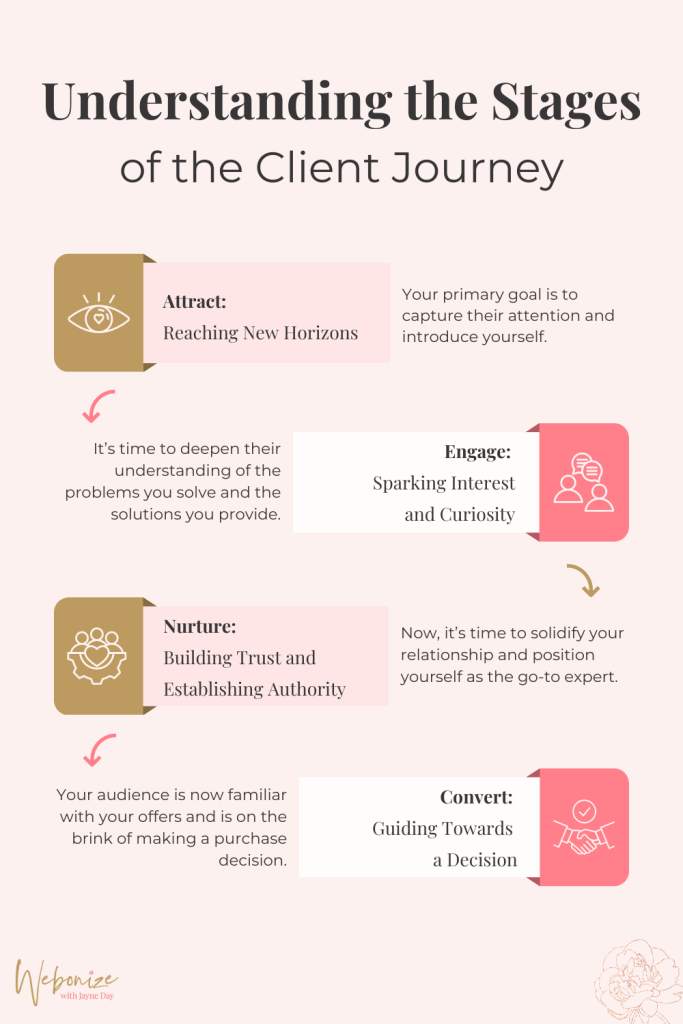In the fast-paced world of online marketing, it’s easy to fall into the trap of simply broadcasting content across various platforms, hoping something will resonate with your audience.
However, as savvy business owners, we know that a more strategic approach is necessary to truly engage and convert our ideal clients.
Let’s look at how you can structure a holistic marketing strategy that delivers results by addressing each stage of your client’s journey.
The Power of an Integrated Marketing Framework
A successful marketing strategy is more than just choosing platforms and creating content. It’s about developing an integrated framework of marketing pillars that work in harmony. This holistic approach ensures that you’re not just reaching your audience, but you’re guiding them through a carefully crafted journey from awareness to conversion.
Understanding the Stages of the Client Journey
To create an effective strategy, it’s crucial to understand and address each stage of your client’s journey.
Let’s break down these stages and explore how to tailor your marketing efforts accordingly:
- Attract: Reaching New Horizons
At this initial stage, your audience is unaware of your existence and the solutions you offer.
Your primary goal is to capture their attention and introduce yourself.
Key Strategies:
- Focus on educational content that addresses general pain points in your niche
- Utilise storytelling to create emotional connections
- Leverage platforms like social media (organic and paid), podcasts, blogs, and SEO
Content Ideas:
- Informative blog posts about common industry challenges
- Engaging social media posts that highlight relatable problems
- Podcast appearances where you share your expertise
- Engage: Sparking Interest and Curiosity
Once your audience is aware of your presence, it’s time to deepen their understanding of the problems you solve and the solutions you provide.
Key Strategies:
- Continue educating through storytelling
- Showcase your unique perspective on industry issues
- Offer valuable resources to encourage further interaction
Content Ideas:
- Email sequences that dive deeper into specific problems and solutions
- Lead magnets such as quizzes, guides, or workbooks
- Social media content that encourages dialogue and shares insights
- Nurture: Building Trust and Establishing Authority
At this stage, your audience recognizes you and the problems you address.
Now, it’s time to solidify your relationship and position yourself as the go-to expert.
Key Strategies:
- Highlight your experience and results
- Address common concerns and objections
- Differentiate yourself from competitors
- Begin introducing your specific offers
Content Ideas:
- Case studies showcasing client success stories
- In-depth blog posts or videos addressing frequently asked questions
- Email campaigns that highlight your unique methodology
- Webinars or challenges that provide immense value while subtly introducing your offers
- Convert: Guiding Towards a Decision
Your audience is now familiar with your offers and is on the brink of making a purchase decision.
This is where you provide that final push towards conversion.
Key Strategies:
- Leverage social proof through testimonials and case studies
- Provide clear, compelling calls-to-action
- Address any last-minute objections or concerns
Content Ideas:
- Detailed case studies highlighting transformative results
- Email sequences that outline the specific benefits of your offers
- Limited-time promotions or bonuses to encourage action
- Webinars or live Q&A sessions to address final concerns

Crafting Your Holistic Marketing Strategy
Now that we’ve explored each stage, it’s time to bring it all together into a cohesive strategy.
Here’s how to approach this:
- Message Alignment: Ensure your messaging evolves appropriately for each stage, gradually building from general awareness to specific solutions.
- Content Variety: Develop a mix of content types (blogs, videos, social posts, emails) that cater to different learning styles and preferences.
- Platform Selection: Choose platforms that align with your audience’s behaviour at each stage. For example, use broader reach platforms like social media for attraction, and more targeted channels like email for nurturing and conversion.
- Consistent Branding: Maintain a consistent voice and visual identity across all stages to build recognition and trust.
- Data-Driven Refinement: Regularly analyse your results and be prepared to adjust your strategy based on what resonates most with your audience.
- Seamless Transitions: Create smooth pathways for your audience to move from one stage to the next, guiding them naturally towards conversion.
Remember, the key to a successful holistic marketing strategy is alignment.
Your message, content, and chosen platforms should all work together to meet your audience where they are in their journey, gently guiding them towards a purchase decision.
By implementing this strategic approach, you’ll not only attract more of your ideal clients but also build stronger relationships that lead to long-term success.
So, are you ready to transform your marketing from a scattered approach to a powerful, results-driven strategy?
Your audience is waiting – it’s time to meet them with the right message, at the right time, in the right place. Want a simple system that will cover the first 2 stages for you on autopilot – Attract and Engage? You can set up an automated system within a couple of hours using a couple of simple Facebook and Instagram Ads that you can start for as little as a couple of dollars a day.
Learn the exact steps on how to do it for yourself using my Invisible Ad Funnel Playbook


















I would love to hear your thoughts...